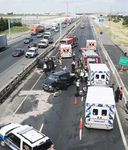Intelligent Transportation Systems Report for Mobile - GSMA Connected Living Programme
←
→
Page content transcription
If your browser does not render page correctly, please read the page content below
Intelligent Transportation Systems Report for Mobile GSMA Connected Living Programme Copyright © 2015 GSM Association
Intelligent Transportation Systems Report for Mobile 1 Contents 0. Executive Summary 5 0.1 Intelligent Transportation Systems 5 0.2 Standards, communications and cloud-based computing in ITS 5 0.3 Intelligent Mobility and Cooperative ITS 5 0.4 Enforcement and security 5 0.5 Fleet Management, Pay As You Drive Insurance & Parking 6 0.6 Road Pricing 6 0.7 Public Transport/Transit 7 0.8 Travel information and Traffic management 7 0.9 Smart cities and the Internet of Things (IOT) 8 0.10 Conclusions and recommendations 9 1. Introduction to Intelligent Transportation Systems 11 1.1 Intelligent Transportation Systems 11 1.1.1 Intelligent Mobility 11 1.1.2 Telematics 12 1.2 A brief history of ITS 12 1.3 ITS markets and prospects 13 1.4 The European Commission’s ITS Action Plan and Directive 14 1.4.1 eCall 15 2. Standards, communications and cloud-based computing in ITS 17 2.1 Short-range communications 17 2.1.1 CEN DSRC 5.8 GHz 17 2.1.2 US DSRC 5.9 GHz - WAVE 18 2.2 Wide area communications 19 2.2.1 Broadcast communications 19 2.2.2 Cellular radio in ITS 19 2.3 Smart phones 20 2.4 Cloud-based computing 21 3. Intelligent Mobility and C-ITS 23 3.1 Cooperative ITS 23 3.2 The connected car and autonomous vehicles 24 3.2.1 The connected car 24 3.2.2 Driver support and Intelligent Speed Adaptation (ISA) 25 3.2.3 Autonomous vehicles and self-driving cars 26 3.2.4 NHTSA five levels of vehicle automation 27 4. Enforcement and security 29 4.1 Enforcement 29 4.1.1 European Cross-border enforcement 29 4.1.2 Enforcement technology 29 4.2 Networking & security in vehicles 29 4.2.1 BMW ConnectedDrive 31 4.2.2 Telematics dongles 32 5. Fleet Management, PayAsYouDrive Insurance & Parking 33 5.1 Fleet management 33 5.1.1 Fleet management in Europe 33 5.1.2 Fleet Management in Russia/CIS and Eastern Europe 34 5.1.3 Fleet Management in China 34 5.2 PAYDI & UBI 35 5.3 Parking 36 5.3.1 Parking objectives, principles and practice 36 5.3.2 New York City 36 5.3.3 Westminster, London 36 5.3.4 Other parking schemes and apps 37 6. Road Pricing 39 6.1 Technology of road pricing 40 6.1.1 Microwave tag-and-beacon 40 6.1.2 Satellite-based charging 40 6.2 Road tolling 41 6.2.1 Road tolling in Europe 42
Intelligent Transportation Systems Report for Mobile 2 6.2.2 Road tolling in the US 45 6.2.3 HOV and HOT lanes 46 6.3 City congestion charging 47 6.3.1 Singapore 47 6.3.2 The London Congestion Charge 48 6.3.3 The Stockholm and Gothenburg Congestion Tax 49 6.3.4 New York 50 6.3.5 Other cities 51 6.4 National/regional/wide area charging 52 6.4.1 The Dutch Pay Per Use Scheme 52 6.4.2 China and Hong Kong 52 6.4.3 The future for Road Pricing – and opportunities for MNOs 53 7. Public Transport 55 7.1 Bus, Metro, Train 55 7.1.1 Dubai 56 7.1.2 Dallas Area Rapid Transit (DART) 57 7.1.3 JustRide in Athens 57 7.1.4 Other smart-ticketing operations 57 7.1.5 Matatus - Nairobi 58 7.2 Car sharing and car clubs 59 7.2.1 Zipcar 60 7.2.2 DriveNow 60 7.2.3 London: the Car Club Coalition and Westminster 60 7.2.4 Uber, Lyft and other ridesharing businesses 61 7.3 Cycling and Scooter hire 61 8. Travel information and Traffic management 63 8.1 Public Transport Information 63 8.1.1 User needs in public transport information systems 63 8.1.2 London buses 64 8.1.3 App Quest: New York State and AT&T 65 8.1.4 My MTA Tracker 65 8.2 Traveller & Traffic information 65 8.2.1 The Singapore Land Transport Authority (LTA) 65 8.2.2 Waze 66 8.3 Traffic Management 67 8.3.1 Managed Motorways & Smart Motorways 67 8.3.2 Smart Maintenance of Dublin’s ITS Infrastructure 67 8.3.3 BMW ConnectedDrive: regular automatic navigation map updates 68 8.4 Smart Environment – traffic pollution management 68 8.5 Social Media in Transport 69 8.5.1 Moovit 69 8.5.2 AASHTO and social media 69 8.5.3 Gamification in transport 70 9. Smart cities and the Internet of Things (IOT) 71 9.1 Smart cities 71 9.2 M2M and the Internet of Things 72 9.3 The embedded Universal Integrated Circuit Card - eUICC 73 10. Conclusions and recommendations 75 10.1 General recommendations 75 10.2 Specific recommendations 77 11. References and further reading 79 11.1 References 79 11.2 Further reading 80 11.2.1 Relevant GSMA publications 80 11.2.2 Other publications 80 11.2.3 Useful websites 80 12. Appendix - Glossary of acronyms and terminology 81
Intelligent Transportation Systems Report for Mobile 3
Figures
Figure 1: C-ITS Gap Analysis 24
Figure 2: Westminster ParkRight parking app 37
Figure 3: Microwave tag-and-beacon charging technology with camera enforcement 40
Figure 4: Satellite-based charging technology 41
Figure 5: The two main technologies of EETS 42
Figure 6: The windshield of a toll-compliant truck today 43
Figure 7: The Stockholm congestion charging scheme boundary. 49
Figure 8: A Stockholm congestion charging scheme gantry. 50
Figure 9: The Du Transport app and the Etisalat Mobile NFC app 56
Figure 10: A matatu (public bus) in Nairobi 58
Figure 11: Nairobi matatu routes 59
Figure 12: Integrating the management of Dublin’s ITS Assets through web-based and
android app solution 68
Figure 13: eUICC Subscription Manager architecture 74
Disclaimer
The information contained in this document is for general information purposes only. The
information is provided by the GSMA and while we endeavour to keep the information
up to date and correct, we make no representations or warranties of any kind, express or
implied, about the completeness, accuracy, reliability, suitability or availability with respect
to the document or the information, products, services, or related graphics contained on the
document for any purpose. Any reliance you place on such information is therefore strictly
at your own risk. In no event will we be liable for any loss or damage including without
limitation, indirect or consequential loss or damage, or any loss or damage whatsoever
arising from loss of data or profits arising out of, or in connection with, the use of this
document.Intelligent Transportation Systems Report for Mobile 5 0. Executive Summary 0.1 Intelligent Transportation Systems Intelligent Transportation Systems (ITS) is the use of Information Technology, sensors and communications in surface transport applications - especially roads. ITS is a major sector of the US economy: 3,000 companies with 445,000 jobs; bigger than computers, movies and internet advertising. The global ITS market will be USD30 billion by 2020. ITS can reduce congestion, accident rates, energy consumption and greenhouse gas emissions. 0.2 Standards, communications and cloud-based computing in ITS Cellular radio and smart-phone development are expanding many areas of ITS. The GSMA has set up the Automotive Special Interest Group (ASIG) to enable dialogue between mobile operators and vehicle manufacturers. The global cloud computing market is growing at 30% CAGR. 0.3 Intelligent Mobility and Cooperative ITS There are Intelligent Mobility and Cooperative ITS (C-ITS) programmes world-wide, with wireless data exchange from vehicle to infrastructure (V2I) or vehicle to vehicle (V2V). “Connected cars” and “autonomous vehicles” are “hot topics” world-wide, due to converging interests of MNOs, automotive companies and ITS organisations, influenced by developments in consumer electronics. Priorities of the US Department of Transportation’s “ITS Strategic Plan 2015-2019” are: “Realising connected vehicle implementation and advancing automation”. Autonomous vehicles have now entered public and political consciousness – largely due to the Google self- driving car. 0.4 Enforcement and security Autonomous and connected vehicles are susceptible to hacking; researchers have demonstrated attacks, though none have occurred as yet in the “real world”. Viruses or malware in smart-phones, music-players or USB sticks can infect automotive electronics. Vehicles contain 100 electronic control units and 10 million lines of software; they are vulnerable because of their real-time operation, components from different suppliers and difficulty of updating security software. Concerns have reached the highest levels, including the World Economic Forum and the US Senate. GPS location signals used by smart-phones and in-vehicle systems can be spoofed or jammed. Defence mechanisms against cyber attacks of automobiles must be designed. MNOs can contribute because of their expertise in authentication and security.
Executive Summary 6 0.5 Fleet Management, Pay As You Drive Insurance & Parking Fleet management includes optimal routing, and monitoring of vehicle health and driving style. At least 80% of freight traffic by weight – more by value - travels by road; it is vital to national economies. The fleet management markets in Europe, Russia/CIS and China have annual growth rates of 14%, 16% and 23% respectively. Penetration will reach 20% by 2019. GPRS meets the key parameters of area coverage, network latency and data bandwidth; 3G/4G technologies will bring increased uplink speeds and reduced latency, improving the end-user experience and creating opportunities for MNOs. Pay As You Drive Insurance (PAYDI – aka Usage-Based Insurance - UBI) is an expanding field, doubling annually in some cases, as insurance companies reduce costs and acquire more sophisticated tools to categorise drivers, using “dongles” with GPS receiver and SIM card in the vehicle OBD, or smartphone apps. PAYD/UBI are new sources of growth for MNOs as the mobile phone voice market saturates. Helping drivers find parking spaces minimises congestion and pollution. Charges can be sent wirelessly to meters. Motorists can pay from their mobile. MNOs and cities use SMS for parking charges in the US, Europe, Australia and United Arab Emirates. 0.6 Road Pricing ‘The potential for benefits from a well-designed, large-scale road pricing scheme is unrivalled by any other intervention’ - though commercially progress has been slow, because of fears of public and political unacceptability. But road pricing is acceptable if it is equitable, revenue- neutral and efficient. Dramatic traffic reduction is achieved with minimal charges, without diversion onto other routes. Satellite technology with mobile communications allows charging by Time, Distance and Place. Germany and Slovakia use GPS/GSM-based truck-tolling schemes, as will Belgium (T-Systems & Belgacom) and Bulgaria. Singapore will migrate to GSM/GPS for all vehicles by 2020. In the US Oregon is trialling road pricing as a ”gas tax” replacement, with one option using a smartphone. Verizon is involved in the trial through insurance company State Farm. California and other western states are closely following the trials. Other countries also have declining revenue from motor (especially fuel) taxes. Mobile operators are used to keeping large volumes of sensitive data secure, so are ideally placed to play a role in road pricing; whether city-based or over wider areas.
Intelligent Transportation Systems Report for Mobile 7 0.7 Public Transport/Transit Public transport works well in high-density urban environments, but less so in rural or suburban environments. It is important with the world-wide trend to urbanisation. Mobile technology allows travel time to be used productively – a trend that MNOs should encourage. Public bodies are making transport data available for app developers, increasing transport efficiency. Benefits of smart-phone Near Field Communication (NFC) include passenger convenience, lower sales and distribution costs, more flexibility, personalised communication with passengers and promotion of public transport. Mobile ticketing will triple between 2013 and 2018. Benefits for mobile operators include greater use of mobile services, upgrading of handsets and UICCs, and a platform for mobile commerce. Car-pooling and dynamic ride-sharing, encouraged by mobile technology, reduce congestion and pollution, and commuter costs. Zipcar (Avis) claims to be the world’s leading car sharing club, based in North America and Europe. DriveNow (BMW/Sixt) operates in Europe and San Francisco. Some companies, including Uber (Google) and Lyft, have turned dynamic ride- sharing into a successful business. Car-pooling, car clubs and dynamic ridesharing rely on mobile technology, and their use will increase. Cycling is increasingly used for short journeys in cities. Customers of cycle-hire schemes use smart-phones to check availability. The Dutch VANMOOF company has GPS connectivity and Vodafone M2M SIMs in its e-bike to combat theft and to map commuter routes. Vodafone sponsors the Barcelona bicycle sharing scheme. Other MNOs could sponsor cycle hire and monitor cycle fleets. 0.8 Travel information and Traffic management Traffic and traveler information play an increasingly part in traffic management, and empower passengers. Car drivers will switch to transit if they can manage their commutes through smartphone apps with real-time information on schedules and delays. Apps are cheaper than electronic displays at bus-stops. So mobile technology and social media can improve the passenger experience and benefit the transport operator and the MNO. The annual “App Quest” competition of New York State’s Metropolitan Transportation Authority (MTA) uses real-time data sets and APIs, with $50,000 prize money from AT&T. MNOs could set up similar competitions, generating good publicity, branding opportunities, and network traffic. Road traffic information is supplied by mobile technology. The Singapore Land Transport Authority use drivers’ smart-phones as traffic sensors and to deliver personalised real-time traffic information. The Waze (Google) app generates traffic, mapping and other road data in back-ground mode, and reports on traffic disruptions or fuel prices. Social media, especially Twitter and crowd-sourcing, are important sources of transport information and control. 90% of US States use Twitter and Facebook to publicise traffic incidents, construction projects and safety initiatives; 50% offer mobile apps and 73% have mobile-friendly web sites. But keeping up with public expectations on information supply is challenging – an opportunity for MNOs.
Executive Summary 8 0.9 Smart cities and the Internet of Things (IOT) A smart city uses intelligent technology to sustainably enhance the quality of life. The GSMA has identified 99 smart-city mobile transport products and services worldwide, such as ticketing, intelligent transport systems and traffic information. Deutsche Telekom is rolling out services to German cities. The Amsterdam Smart City project, with KPN Telecom, aims to make it the smartest in the world. Singapore has created 23 mobile apps since 2010. India will build 12 pollution-free smart cities by 2020. Mobile operators can play a role in smart city services by connecting infrastructure and individuals’ handsets to central servers and databases, with data aggregation and analysis to produce new insights, real-time information sent to people and machines, and customer support operations, such as call centers and web portals. The “Internet of Things” (IoT), enabled by Machine to Machine (M2M) communication, is the most promising market in the technology industry according to Samsung; by 2020 all its hardware will be IoT devices. Ford will become a transport data analytics organisation, collecting data from cars and people and turning it into a business, related to vehicle quality, insurance costs, car sharing, driving patterns, parking apps, transportation analysis and societal problems. Daimler-Mercedes-Benz bought RideScout, a US developer of transport apps. The existing mobile spectrum is adequate for IoT applications, but network resilience and data security are increasingly important. IoT will be a heterogeneous collection of technologies operating on both licensed and unlicensed spectrum. The IoT is a major opportunity for MNOs, not only in providing mobile network connectivity, but also in adapting the cellular radio standards to facilitate these new services. A new type of mobile network user will emerge, with billions of embedded devices in vehicles, consumer and industrial electronic equipment, using the “embedded Universal Integrated Circuit Card” (eUICC). The GSMA eUICC specification will accelerate M2M growth by providing a standard mechanism for remote management and “over the air” provisioning, while maintaining the same security as in removable SIMs. Use of the eUICC can minimise some of the connected car security problems. The eUICC provides new business opportunities for MNOs, safely and with minimal impact to the network infrastructure.
Intelligent Transportation Systems Report for Mobile 9 0.10 Conclusions and recommendations ITS has many communications needs that MNOs can address. MNOs should keep abreast of the field by attending and exhibiting at the annual ITS World Congress, the ITS Asia Pacific Forum and the IEEE and ITS America events. MNOs should participate in ITS standards development, and in collaborative R&D programmes to get experience of new ITS areas and new partnerships. Connected and driverless cars are “hot topics” and mobile communications are crucial. But security is an issue, including in fleet management and Pay As You Drive Insurance; MNOs have relevant expertise, including advocating wider use of eUICCs. Promising long-term areas are road pricing and congestion charging, using satellite positioning and mobile communications. MNOs are used to securing large volumes of sensitive data, so are well-placed to collaborate with administrations, since privacy and mistrust of Governments are issues. Public and private transport systems are improved by using mobile communications and smartphones, including car sharing , car clubs, bicycle security schemes and cycle hire – and also can attract new mobile subscribers. Mobile technology and social media improve the public transport experience and benefit transport operators and MNOs. Sponsoring competitions to develop transport apps will generate good publicity, branding opportunities, and network traffic. Mobile technology and crowd-sourcing can augment infrastructure-based traffic data sensors. By making transport more efficient, mobile technology improves the environment. MNOs have important roles to play in Smart Cities and the Internet of Things. They should partner with or acquire technology companies, consultancies or systems integrators to facilitate solutions, including connecting city infrastructure and individuals’ handsets to central servers and databases, combining data from multiple sources to produce new insights; delivering real- time information to people and machines, and providing customer support operations, such as call centers and web portals – though a prerequisite is the adaptation of the cellular network standards to facilitate these new services.
Executive Summary 10
Intelligent Transportation Systems Report for Mobile 11 1. Introduction to Intelligent Transportation Systems Intelligent Transportation Systems (ITS) is an expanding and diverse subject, though some of its areas are becoming linked or are converging and overlapping. For example, transport and travel information might have been covered under Smart Cities rather than being a separate section; similarly “connected cars” are a manifestation of Machine-to-Machine (M2M) communications and the Internet of Things (IoT). Note that items likely to be of commercial interest to MNOs are highlighted in italics throughout the text. 1.1 Intelligent Transportation Systems Intelligent Transportation Systems (ITS) is the use of Information Technology (IT), sensors and communications technologies for surface transport applications - though road transport applications vastly predominate. Road and other infrastructure building is expensive and environmentally unfriendly; we can make better use of the civil infrastructure by using a broad range of electronic technologies, making transportation systems safe, efficient, reliable and environmentally friendly, without implementing new physical infrastructure. ITS cuts across disciplines such as transportation, engineering, telecommunications, computer science, finance, electronic commerce and automotive manufacturing. Use of wireless/radio mobile communications and satellite positioning systems are particularly important. The ITS field probably has more than its fair share of acronyms. Where possible, each one will be explained when it is first introduced but a complete list will be found in section 12.1. ITS also a big subject, and what were previously distinct and separate areas are now starting to overlap, partly though the influence of mobile communications - as we will see in this Report. 1.1.1 Intelligent Mobility The term “Intelligent Mobility” has gained currency, particularly amongst automobile manufacturers. It is not clear how it differs from ITS. The UK Automotive Council uses it to describe the convergence between electronic communications technologies and transport systems, which up to now have been developed in isolation, to create a safer, intelligent, highly interlinked transport network. The key to Intelligent Mobility lies in connecting a range of independent industries and technologies such as vehicle manufacturing, transport information systems, communications technologies, logistics and distribution and infrastructure management. The EU has an iMobility Support operation to foster the deployment of intelligent mobility in Europe. http://www.imobilitysupport.eu/
Introduction to Intelligent Transportation Systems 12 1.1.2 Telematics Wikipedia defines telematics as an interdisciplinary field encompassing telecommunications, vehicular technologies, road transportation, road safety, electrical engineering and computer science. However the term is most commonly used in the transport field and this is how we will use it here. (Indeed ITS was once known as “Transport Telematics” - first coined by the French as “télématique”, combining “telecommunications” and “informatics”). It usually refers to fleet management, where haulage companies, car hire organisations and other companies manage their vehicle fleets, including optimal routing, monitoring of vehicle health and driving style. For a time “telematics” was particularly applied to technology used in the automotive insurance industry, but the more specific terms Pay As You Drive Insurance (PAYDI) and Usage-Based Insurance (UBI) (section 5) are now favoured . 1.2 A brief history of ITS Research on the application of control and information technologies to surface transportation began in the 1950s and 1960s in the United States, including automatic control of the automobile and electronic route guidance. In the late 1980s a coalition of private, public and academic organisations convinced Congress to legislate support for a comprehensive program in Intelligent Vehicle-Highway Systems (renamed Intelligent Transportation Systems or ITS in 1994) to reflect a broader mission, including all parts of public transportation and intermodal connections. The potential benefits of ITS had not gone unnoticed Europe. In 1987 the European Commission (EC) announced its DRIVE (Dedicated Road Infrastructure for Vehicle safety in Europe) research program, aimed at employing information technology to improve the efficiency of road transport and road safety, and to reduce its environmental effect. The subsequent DRIVE 2 and following “Framework” programs have continued this initiative. In the same timeframe, in mobile communications, Europe was adopting the first generation cellular radio systems, and developing its second generation system GSM (Global System for Mobiles).
Intelligent Transportation Systems Report for Mobile 13
1.3 ITS markets and prospects
In 2011 ITS was identified by ITS America as a major sector of the US economy, comprising
3,000 companies with total revenues of $48 billion in 2009, with 180,000 private sector jobs in
the end-use market, and 445,000 jobs in the total industry value chain; end-use revenue was
predicted to increase by 41% by 2015, and total industry employment to exceed 500,000. ITS
market revenues exceeded those for electronic computers, motion picture and video products,
and internet advertising. The 2015 total U.S. private sector ITS market was projected to be $67
billion1.
A June 2014 report by Juniper Research on the telematics sector says that the number of
in-vehicle apps in use is expected to reach 269 million by 2018, representing a more than
fivefold increase on 2013. According to the report “Connected Cars: Consumer & Commercial
Telematics and Infotainment 2014-2018”, growth will be fuelled by solutions such as Apple’s
CarPlay, which will promote in-vehicle apps to the mainstream, and app integration will be
facilitated as standardised approaches like MirrorLink are adopted by OEMs, content providers
and automotive entertainment specialists.
The Electronic Toll Collection System Market is forecast to reach $9.5 Billion in 2020. Tolls are
collected using electronic equipment installed on the roadside and without reducing vehicle
speed, particularly on highways and in congested cities.
According to MarketsandMarkets (“Intelligent Transport Systems Market by System (ATMS,
ATIS, ITS- Enabled Transportation, Pricing System, APTS and CVO), by Component, Application
and Geography (Americas, Europe, Asia-Pacific, ROW) Analysis and Forecast to 2014 - 2020”2
the ITS market will grow at a CAGR of 11.3% from 2014 to 2020 and reach $33.75 Billion. The
major market share is in the US, followed by Europe.
A growing focus on efficient traffic management drives the global ITS market, according to a
new report by Global Industry Analysts, Inc. (April 2014). It will reach US$26.3 billion by 2020,
driven by continued rise in vehicular traffic and the need to regulate traffic flow, enhance road
safety, and escalate awareness of the socio-environmental implications of traffic congestion.
Grand View Research, Inc forecasts the global ITS Market will reach USD38.68 Billion by 2020.
Growing demand for optimising fuel consumption and reducing emissions will be the key
driving forces. ITS can reduce incidents and improve safety. North America accounted for 43.8%
of the global market in 2013 and will remain the dominant ITS market over the next six years
because of favorable regulatory initiatives from transportation authorities for increasing driver
safety and reducing traffic congestion. Asia Pacific will register the fastest growth of 14% from
2014 to 2020, as a result of a need to improve transportation networks and high ITS growth
expected in India and China to tackle congestion and energy consumption.
1. http://www.itsa.org/knowledgecenter/market-data-analysis
2. ATMS: Advanced Traffic Management Information Systems; ATIS: Advanced Traveler Information Systems; APTS: Advanced Public Transportation Systems; CVO: Commercial Vehicle Operations; ROW: Rest Of the World;
CAGR: Compound Annual Growth Rate.Introduction to Intelligent Transportation Systems 14 A new “hot topic” is “self-driving cars” (aka autonomous vehicles), still in the research stage but sales are forecast to explode over the next decade. Automotive and other companies are racing to develop them, including Audi, Daimler, Google. ■ Sales will increase from 230,000 in 2025 to 11.8 million by 2035, says IHS Automotive, with a cumulative total of 54 million self-driving cars in use worldwide. By 2050, nearly all vehicles — private and commercial — will be self-driving cars, and the roads will be safer. Traffic congestion and air pollution per car will also decline, because cars can be programmed to be more efficient in their driving patterns. A third of all global sales in 2035 will be in North America. Many cars already have the technologies needed for self- driving, such as lane-keeping assist and automated braking. But self-driving cars will add $7,000 to $10,000 to a car’s price in 2025, dropping to $5,000 in 2030 and $3,000 in 2035. The two big barriers to development are software reliability and cyber security. Governments will play a key role, setting the rules for deployment. ■ According to an October 2013 market report from Transparency Market Research “Connected Car Market -Global Industry Analysis, Size, Share, Growth, Trends and Forecast, 2013- 2019,” the global connected car market will reach USD 131.9 billion by 2019, growing 34.7% per year from 2013 to 2019. 4G/long-term evolution (LTE) technology is in a commanding position to supply this connectivity due to its lower operating costs and high data transmission volumes compared to other technologies. The market is primarily driven by changing consumer preferences and growing awareness of safety and security, as well as the need for connectivity, and government mandates; inhibiting factors include high hardware cost and risk of driver distraction. Rapid advancements in network technology serve as an opportunity, fuelling the growth of this market. The connected car market has been segmented into 4G (LTE), 3G (UMTS, HSPA, HSPA+)3, and 2G (GSM, GPRS, EDGE)4. Mobile network operators (MNOs) will play a vital role in the future of the connected car and will have to work with car OEMs, says the GSM Association. 1.4 The European Commission’s ITS Action Plan and Directive The European Commission’s ‘Action plan for the deployment of intelligent transport systems in Europe’ — the ‘ITS action plan’ — aims to make road transport, and its interfaces with other transport modes, more environmentally friendly, more efficient, safer and more secure. Deployment of ITS in Europe needs to be accelerated in a coordinated way and European standards, for example for the exchange of data, should be set. This plan and the accompanying proposal for a directive laying down the framework for the deployment of ITS, were both adopted in 2008 (EC 2008, 2009). The EU wants to encourage ‘co-modality’ (the efficient use of different transport modes together and separately), to cut congestion, reduce the number of road traffic accidents, reduce energy consumption, cut greenhouse gas emissions and reduce dependence on fossil fuel. The plan is a response to the slow and fragmented deployment of ITS in road transport in Europe. Possible ITS applications include electronic tolling, dynamic traffic management with variable speed limits, parking guidance and reservation, navigation devices and driver assistance systems. 3. LTE: Long Term Evolution; UMTS: Universal Mobile Telecommunications Service - the ETSI third generation mobile radio standard; HSPA: High Speed Packet Access 4. GSM: Global System for Mobiles; GPRS: General Packet Radio Service; EDGE: Enhanced Data rates for GSM Evolution
Intelligent Transportation Systems Report for Mobile 15 A new legal framework (Directive 2010/40/EU) was adopted on 7 July 2010 to accelerate the deployment of ITS across Europe, aiming to establish interoperable and “seamless” ITS services while leaving Member States the flexibility to decide which systems to implement. By 2017 the European Commission has to adopt functional, technical, organisational or service provision specifications to address compatibility, interoperability and continuity of ITS solutions across the EU. The Directive identifies four Priority areas and actions: ■ Optimal use of road, traffic and travel data; ■ Continuity of traffic and freight management ITS services; ■ Road safety and security applications; ■ Linking the vehicle with the transport infrastructure. The Action Plan is supported by five Directorates-General: Mobility and Transport (lead); Communications Networks, Content & Technology; Research & Innovation; Enterprise and Industry; Climate Action. 1.4.1 eCall eCall is an EC initiative aiming to bring help to motorists involved in a collision anywhere in the European Union. An eCall-equipped vehicle monitors its in-vehicle sensors for events such as airbag deployment and automatically sends a “Minimum Set of Data” including the location of the crash, to the nearest emergency centre via the cellular network, permitting a rapid and potentially life-saving response by the emergency services. SMS and GPRS are not suitable for eCall due to delays; an “in-band modem” is used to send data over the voice channel, compliant with the 3GPP specification TS 26.267: “eCall Data Transfer; In-band modem solution; General Description.” eCall was planned to be operational throughout Europe by the end of 2015, but progress has been slow and the current deadline is likely be 2018. http://ec.europa.eu/digital-agenda/en/ecall-time-saved-lives-saved
Introduction to Intelligent Transportation Systems 16
Intelligent Transportation Systems Report for Mobile 17 2. Standards, communications and cloud-based computing in ITS There are many standards relating to ITS in general and to communications in ITS in particular – see for example “D3.5b – Standardisation Handbook” (Evensen & Schmitting, 2014). 2.1 Short-range communications Dedicated Short-Range Communications (DSRC) is much used in ITS. There has been standardisation activity in this area going back 20 years. But the term DSRC is ambiguous; DSRC in the US context is different from the European usage, particularly in tolling systems. 2.1.1 CEN DSRC 5.8 GHz CEN/TC 278 was established in 1992 and coordinates with ISO/TC 204 Intelligent Transport Systems, which is responsible for developing international standards, and with the European Telecommunications Standards Institute (ETSI) which produces globally-applicable standards for telecommunications and ITS. CEN DSRC is the 5.8 GHz system developed by the European Committee for Standardisation’s Technical Committee TC278 Working Group 9 (ISO WG15) and used for tolling systems world- wide, though both these working Groups are currently dormant. Its full list of Working Groups is: WG 1 Electronic Fee Collection WG 2 Freight, Logistics and Commercial Vehicle Operations WG 3 Public Transport WG 4 Traffic and Travel Information WG 5 Traffic Control Systems WG 6 Parking management (disbanded) WG 7 Geographic Data Files WG 8 Road Traffic Data WG 9 Dedicated Short Range Communications (dormant) WG 10 Human-Machine Interfacing WG 12 Automatic Vehicle and Equipment ID. WG 13 Architecture and Terminology WG 14 Recovery of stolen vehicles WG 15 eSafety / eCall WG 16 Cooperative systems WG 9 produced 4 basic standards between 1993 and 2001, which provide the basics of tolling systems around the world, and applying to what was called at the time “Road Transport and Traffic Telematics” (RTTT). They are: ■ EN 12253:2004 RTTT - Dedicated short-range communication - Physical layer using microwave at 5.8 GHz; ■ EN 12795:2003 RTTT - DSRC data link layer: medium access and logical link control; ■ EN 12834:2003 RTT - DSRC application layer; ■ EN 13372:2004 RTTT -DSRC - Profiles for RTTT applications.
Standards, communications and cloud-based computing in ITS 18 As indicated earlier (section 1.4) the European Commission Directives aim to accelerate the deployment of ITS in Europe, and the Commission has asked the European Standards Organisations to develop and adapt the supporting European standards. The following documents are relevant to CEN/TC 278: ■ EFC Directive 2004/52/EC on the interoperability of electronic toll systems; ■ ITS Directive 2010/40/EU for the deployment of ITS in road transport and for interfaces with other transport modes; ■ Commission Decision 2009/750/EC on the definition of the European Electronic Toll Service (EETS); ■ Mandate M/338 on Electronic Fee Collection in support of Interoperability of electronic road toll systems; 19 standards have been published and 22 are under development; ■ Mandate M/453 on Co-operative ITS (C-ITS); ■ 2010-2013 EC ICT standardisation work programme to promote use of standards to increase interoperability between services and applications; several standards are being developed, including eCall (section 1.4.1); ■ The ITS action plan identifies priority areas for a wider and more coordinated deployment and use of ITS. For more information see http://www.itsstandards.eu/ 2.1.2 US DSRC 5.9 GHz - WAVE DSRC is also used in the United States as a synonym for WAVE (Wireless Access in the Vehicular Environment - the 5.9 GHz IEEE standard, document number 1609). Provision of external services to vehicles has previously been limited because of the lack of high-speed communications between vehicles and service providers, and homogeneous communications interfaces between automotive manufacturers. The IEEE 1609 Family of Standards for Wireless Access in Vehicular Environments (WAVE) addresses the latter issue, and provide a foundation for the former. They define an architecture and a set of services and interfaces that enable secure vehicle-to-vehicle (V2V) and vehicle-to-infrastructure (V2I) wireless communications, permitting a range of applications in transportation, including vehicle safety, road tolling, navigation, and traffic management. Existing active standards include: ■ 1609.0-2013 IEEE Guide for Wireless Access in Vehicular Environments (WAVE) - Architecture ; ■ 1609.2-2013 IEEE Standard for Wireless Access in Vehicular Environments — Security Services for Applications and Management Messages Active Standard; ■ 1609.3-2010 IEEE Standard for Wireless Access in Vehicular Environments (WAVE) - Networking Services; ■ 1609.3-2010/Cor 1-2012 IEEE Standard for Wireless Access in Vehicular Environments (WAVE)--Networking Services Corrigendum 1: Miscellaneous Corrections; ■ 1609.4-2010 IEEE Standard for Wireless Access in Vehicular Environments (WAVE) - Multi-channel Operation. For more details see http://standards.ieee.org/develop/wg/1609_WG.html and http://www.standards.its.dot.gov/Factsheets/Factsheet/80#sthash.iRyF2xgA.dpuf
Intelligent Transportation Systems Report for Mobile 19 2.2 Wide area communications 2.2.1 Broadcast communications Traffic and Travel Information (TTI) services may be delivered by “1-to-1” (point-to-point) or “1-to-a few” channels (point-to-multipoint) such as provided by mobile phone networks, or they may be delivered by “1-to-many” channels using broadcast technology. The former has significant cost. Currently, FM-broadcast TTI data services are delivered using a narrow band channel which is part of the RDS (Radio Data System) . RDS-TMC (Radio Data System – Traffic Message Channel) services are delivered in a sub-carrier channel of fixed bandwidth that is added to existing FM transmissions with virtually no impact on the audio channel and with no specific need for regulatory intervention. Consequently TMC based services have spread worldwide where FM radio is available. ERTICO and TISA (the Traveller Information Services Association) expect RDS-TMC services to continue for many years, but gradual transition to Transport Protocol Experts Group (TPEG) based services delivered via Digital Radio is likely, to deliver significantly more TTI content including safety information, multi-modal information (e.g. Public Transport) and on-trip enhancements such as traffic flow and prediction, fuel prices and Points-Of-Interest (POI) information. TPEG based services are operational in the US, Western Europe and Australia, and are planned in China. Digital Radio is normally the TTI data delivery channel for TPEG based services. Its technical structure is significantly different from FM Radio; due to multiplexing of the audio and data services a more complex scheme is required to accommodate all services within a particular transmission area. In Europe, TPEG-based TTI services must be delivered via Digital Radio to meet the objectives of the European Commission’s ITS Action Plan and Directive (section 1.4). 2.2.2 Cellular radio in ITS Cellular radio in all its incarnations (2G (GSM, GPRS, EDGE), 3G (UMTS, HSPA, HSPA+), 4G (LTE) and in the not too distant future 5G) is an enabler of many new developments in ITS. Mobile Network Operators will play an important role in ITS in the future and are looking to ITS as an expanding market for their data services. Almost half the world’s population now uses mobile communications - 3.4 billion by the end of 2013, and expected to pass 4 billion in 2018, with strongest growth in Asia-Pacific. Developed markets’ connection and subscriber growth is slowing – subscriber numbers will grow at just 1% p.a. between now and 2017 in Europe and North America due to market maturity. However, total connections will grow at 9% -10% p.a. due to strong Machine-to-Machine (M2M) connections growth - 1.2 billion connected devices by 2017 (GSMA 2013b). Much of this will be in the automotive and ITS sectors. The 2020 Addressable opportunity for MNOs in the automotive sector is forecast to be US$196Bn (GSMA 2014b).
Standards, communications and cloud-based computing in ITS 20 Mobile data continues to drive rapid traffic growth for mobile operators with all regions showing impressive data volume growth rates as more people connect to the internet via mobile. In emerging markets, growth will be driven by the increased penetration of smartphones, while in developed markets it will be driven by both greater smartphone adoption and by increased download speeds made possible by new technology - two thirds of subscribers will be on 3G and 4G networks by 2020. Total traffic volumes in 2012 alone exceeded all the previous years combined and globally data is projected to grow by 66% p.a. through 2017 to 11.2 exabytes per month (GSMA 2013b, 2014b). “Connected car” (section 3.2.1) penetration will increase globally from 11% in 2012 to 60% in 2017 (and to more than 80% in the United States and Western Europe). Mobile technology can revolutionise the way we use cars, saving lives, improving the driving experience through access to real-time information, allowing remote monitoring of performance and location for more effective preventative maintenance measures, delivery networks and public transport travel information (GSMA 2013b). Payment systems will be facilitated and part or even all of the driving task will be automated, as will be shown below (section 3.2.3). The GSMA has set up the Automotive Special Interest Group (ASIG)to enable dialogue between mobile operators and vehicle manufacturers. By working together, manufacturers and mobile operators can share information, resolve barriers to connected car deployment and accelerate the adoption of telematics and infotainment services. The ASIG has set targets for connectivity solutions to be embedded in over 20% of global vehicle sales, and over 50% of cars to be connected, by 2015 – as outlined in the Mission Statement; it hopes to have every car multiply connected by 2025 (GSMA 2013b). 2.3 Smart phones Although smartphones have a history going back to the mid-1990s with the Nokia 9000, they really took off in the mid-2000s with the Blackberry, the Apple iPhone and the Google Android operating system. They have continued to gain in computing power, connectivity (Wi-Fi and Near Field Communications (NFC) as well as cellular), screen size and resolution, and sensor facilities (cameras, GNSS positioning, motion-sensing) – and this trend seems set to continue for the foreseeable future. By the end of 2013, there were 1.5 billion smartphones in use world-wide, of which half were in Asia Pacific. By 2017 there will be 3 billion, with 1.6 billion in Asia-Pacific, 500 million in the Americas, 400 million in Europe, and 300 million in Africa-Middle-East. Global smartphone penetration will rise from 19% in 2012 to 32% in 2017; in Sub-Saharan Africa it will grow from 4% to 20%, in Latin America, from 20% to 44%. Six in 10 global 4G-LTE connections will come from developing regions by 2020 (GSMA 2013b, 2014b, 2014c). This ubiquity, power and versatility of smart-phones, as sensor platforms and as generators of useful data, is driving applications in commerce, financial services, infotainment and many other areas, including transport – as covered in later sections of this report.
Intelligent Transportation Systems Report for Mobile 21 2.4 Cloud-based computing In Cloud-based computing, data, applications, services and infrastructure are provided in “the Cloud”, hosted on remote infrastructure, available from anywhere. The advantages are: ■ Highly scalable implementation; the cloud operator can support sudden changes in computational requirements. ■ The Cloud operator handles back-up and software upgrades, with resulting economies of scale. ■ All users can access the latest data. ■ Terminals & user devices can be of lower computing power. ■ There is less need for specialist IT skills in the organisation, and no need to understand how the service is provided ■ There is no need for large capital outlay; resources can be provided on a “pay as you go” basis. On the downside: ■ High capacity connectivity is essential - potentially an issue for mobile services. ■ Performance may be inadequate; the server may be heavily loaded when the user’s application needs to run, and may be slow. ■ Failure of the Cloud operator’s system could leave users with no back-up. ■ Confidential information is held in the Cloud. ■ Lack of open standards makes it difficult to transfer business between service providers. In the UK, cloud computing is being increasingly used by Local Authorities, including in transport applications. For example the “National traffic disruptions hub” in the UK has been cloud-based since 2003, evolving from a road-works database. The objective is to unite 175 Local Authorities on a common platform for road-works, incidents and other disruptions. Dynamic traffic management information is provided by 40 UK Local Authorities, and is linked to the UTMC (Urban Traffic Management and Control) systems to give a single integrated view of traffic management information. The data is widely disseminated, including to Google, Here (Nokia Navteq), and TomTom. As pointed out by the GSMA (2013a), making use of cloud-based or managed smart city services, billed on a pay-as-you-go basis, is likely to be more cost-effective than deploying the city’s own dedicated infrastructure. A slightly different model is envisaged by the US Federal Highway Administration (FWHA), which in February 2015 issued a request for information for proposals to develop a cloud- based repository for its transportation datasets for use by commercial and other organisations. Companies will partner with FHWA, fund the transfer of data to the cloud and charge customers for access to the data - on roads, bridges, travel and transport generally – since it potentially has economic value. Currently only a small percentage of FHWA data is publicly available. According to Market Research Media, the global cloud computing market will grow at 30% CAGR reaching $270 billion in 2020; one fast growing segment is the “mobile cloud”.
Standards, communications and cloud-based computing in ITS 22
Intelligent Transportation Systems Report for Mobile 23 3. Intelligent Mobility and C-ITS The term “Intelligent Mobility” has gained currency, particularly amongst automobile manufacturers. It is not clear how it differs from ITS; perhaps ITS is perceived as technology- centric whereas IM is perceived as user-centred. The UK Automotive Council has used the term to describe the convergence between electronic communications technologies and transport systems, which previously have been developed in isolation, to create a safer, intelligent, highly interlinked transport network. The key to Intelligent Mobility is to connect a range of independent industries and technologies such as vehicle manufacturing, transport information systems, communications technologies, logistics and distribution and infrastructure management. 3.1 Cooperative ITS The EC ITS Action Plan was addressed in section 1.4. Cooperative ITS (C-ITS) is another term which has gained currency; there are C-ITS programmes in Europe, the US, Japan and Australia. C-ITS includes technologies and applications that allow wireless data exchange within the transport system, between vehicles (V2V), and between vehicles and infrastructure (V2I), but also covers vulnerable road users such as pedestrians, cyclists and motorcyclists. The European Commission has decided to take a more prominent role in the deployment of cooperative systems. To that end, DG MOVE (the Directorate General for Transport and Mobility) is setting up a C-ITS Deployment Platform, a cooperative framework including national authorities and other stakeholders, aiming to develop a roadmap and a deployment strategy for C-ITS in the EU and identify potential solutions to cross-cutting issues, by the end of 2015. In addition to DG MOVE, the Directorates General for Communication Networks Content and Technology (DG CNECT), for Research and Innovation (DG RTD), for Enterprise and Industry (DG ENTR) will also participate. A draft work programme “Gap Analysis: What is to be done for C-ITS Deployment” was developed during 2014, outlining barriers and enablers (EU 2014). There are 200 million vehicles on European roads and some 13 million jobs in the automotive industry, so Europe would like to be in the lead in introducing new technologies. But connected cars need common technical specifications, including radio frequencies and message formats. Hence the Commission’s formal request (Mandate 453, 2009) asking CEN and ETSI to prepare a coherent set of standards, specifications and guidelines to support implementation and deployment of C-ITS across Europe. It was confirmed at the 6th ETSI workshop on ITS in Berlin in February 2014 that these standards were in place. These ‘Release 1 specifications’ will enable vehicles made by different manufacturers to communicate with each other and with the road infrastructure. http://release1.its-standards.eu/
Standards, communications and cloud-based computing in ITS 24
FIGURE 1: C-ITS GAP ANALYSIS
Gap analysis: What is to be done for C-ITS deployment?
WP1 Cost Benefit Analysis
WP2 Business Case for Deployment
WP3 WP4 WP5 WP6 WP7 WP8 WP9
Legal System’s Security & Technical Standardisation Public Implementation
Issues Governance Certification Issues Issues Acceptance Issues
& Privacy
WP10 International Cooperation
WP11 Roadmap for Deployment of C-ITS
Source: European Commission document "Gap Analysis: What is to be done for C-ITS Deployment" (EU 2014).
3.2 The connected car and autonomous vehicles
These topics are driven from two sides. As conventional cellular data and especially voice traffic
become saturated in developed countries, MNOs are increasingly turning to data including
transport applications for new markets. Conversely, automotive companies and ITS industry
are appreciating the benefits and the necessity of using mobile communications technology
View results in map or list
to improve both traffic control and the driving experience. They are also strongly influenced
format
by consumer electronics; in January 2015 the keynote addresses at the Las Vegas Consumer
Electronics Show were given by the Chairmen of Mercedes and Ford, and Clickthe
(or swipe
show fromfeatured
left) to setup
parking duration and apply filters
self-driving cars from Mercedes-Benz, Audi and BMW.
And it is noteworthy that in the US Department of Transportation (USDOT)’s Sort “ITS Strategic
by distance/ price/
availability/rating
Plan 2015-2019” the two primary strategic priorities are: “Realising Connected Vehicle (CV)
Implementation and Advancing Automation” (USDoT 2014).
Filter results by real-time
space availability
3.2.1 The connected car High Availability
Connected vehicles can communicate with each other and their surroundings.Medium
They Availability
are
Low Availability
equipped with internet access, cellular radio, radar and other communication links including
DSRC and an internal wireless local area network, allowing internet access to other devices both
Refresh map
inside and outside the vehicle. Benefits to the driver include prevention or automatic notification
of crashes, speeding and congestion. Increasingly, connected cars use smartphone apps to
interact with the car from any distance. Users can unlock their cars, check the status of batteries
on electric cars, find the location of the car, or remotely activate the climate control system.
Source: Westminster City Council.Intelligent Transportation Systems Report for Mobile 25 As indicated earlier, the market size for the connected car is expected to increase dramatically. According to the GSMA (2013c) the global connected car market will be worth €39 billion in 2018, up from €13 billion in 2012. There will be a sevenfold increase in the number of new cars equipped with factory-fitted mobile connectivity to meet demand among regulators and consumers for safety and security features, as well as infotainment and navigation. This rapid growth will be driven in part by positive regulatory action in Europe, Russia and Brazil. Connected vehicle technology includes the following: ■ Fleet telematics allows emergency services and commercial fleet operators to increase utilisation factors for their vehicles, improve driving standards and fuel efficiency, reducing emissions and vehicle wear. ■ Links to infrastructure systems which manage traffic flows on roads, including Urban Traffic Management & Control, roadside Variable Message Signs to inform drivers of reduced speed limits, traffic jams and other safety messages. ■ Communication with public transport measures including selective vehicle detection, traffic light control and real time passenger information. ■ Vehicle to Vehicle systems (V2V), where vehicles interact with each other using wireless networks, sending information about weather, speed, location, direction of travel, braking, and loss of stability, typically using Dedicated Short-Range Communications (DSRC) at 5.8 or 5.9 GHz, and/or a mesh radio network. ■ Vehicle to Infrastructure systems (V2I) allow wider area dissemination of traffic and safety information, as well as vehicle tracking and recovery, emergency call (e-Call), the set-up of WiFi and 3G hot-spots, reservation of and guidance to parking spaces. Telefónica has an agreement with Tesla to supply connectivity for its in-car infotainment system and remote vehicle diagnostics, in Germany, the UK and Spain. http://www.gsma.com/connectedliving/telefonica-tesla-agreement/ 3.2.2 Driver support and Intelligent Speed Adaptation (ISA) This includes: ■ ADAS (Advanced Driver Assistance Systems), including collision avoidance which support the driving task by reducing work-load and raising awareness of risk. It can be autonomous (contained within the vehicle) or cooperative by interfacing to other vehicles and to infrastructure. ■ Autonomous Cruise Control (ACC) ■ Crash avoidance and Black Box recorders ■ Intelligent Speed Adaptation (ISA) – advice on or control of vehicle speed and driver advisories. There has been much research on ISA, especially in Sweden, Australia and the UK, including a large-scale trial in London, but the transition to wide commercial use still hasn’t happened. It may come about through the widespread availability of smartphones, coupled with the increasing interest in Usage-based Insurance (UBI). Also it is being subsumed into and replaced by the connected car and “autonomous vehicles”.
Intelligent Mobility and C-ITS 26 3.2.3 Autonomous vehicles and self-driving cars Self-driving cars are one of the hottest of current hot topics. Research has been carried out in the US, Western Europe and Asia-Pacific for decades, but the topic has now entered the public and political consciousness – largely due to the Google self-driving car. Autonomous vehicles sense their surroundings using radar, LIDAR (Light Detection And Ranging – like radar but using light instead of microwaves), GPS, and computer vision, and can navigate without human input. Advanced control systems interpret sensory information to identify appropriate navigation paths, as well as obstacles and relevant signage. Autonomous vehicles can update their maps based on sensory input, allowing the vehicles to keep track of their position even when conditions change. 3.2.3.1 Brief history of autonomous vehicles Although self-driving cars have been the subject of research since the 1960s, for example at the UK Transport Research Laboratory (TRL), the first prototype autonomous cars appeared in the 1980s, including Carnegie Mellon University’s Navlab and ALV (Autonomous Land Vehicle) projects and the European Prometheus Project. Since then, numerous organisations have developed vehicles, including Mercedes-Benz, General Motors, Continental Automotive Systems, Autoliv Inc., Bosch, BMW, Nissan, Toyota, Audi, Volvo, Vislab from University of Parma, Oxford University and Google. In July 2013, Vislab demonstrated BRAiVE (BRAin-drIVE), a vehicle that moved autonomously on a mixed traffic route open to public traffic. Four U.S. states have passed laws permitting autonomous cars: Nevada, Florida, California, and Michigan. In Europe, cities in Belgium, France, Italy and the UK are planning to operate transport systems for driverless cars, and Germany, the Netherlands, and Spain have allowed testing of robotic cars in traffic. 3.2.3.2 Autonomous vehicles in 2015 Autonomous vehicles exist mainly as prototypes and demonstration systems. However, as of early 2015, the only self-driving vehicles that are commercially available are open-air slow-speed shuttles for pedestrian zones, though many countries are gearing up to run trials and to amend legislation to permit driverless cars on their roads, and several developments were publicised in late 2014 and January 2015: ■ China held its sixth driverless car competition, “Future Challenge 2014” in Changsu, in the eastern province of Jiangsu. In a two-day competition teams from 14 universities entered 20 self-driving vehicles, which drove on highways and suburban roads plus an urban stage. The cars were assessed on safety, intelligence, smoothness and speed. ■ The Dutch Government announced that the Netherlands would become a testing ground for self-driving vehicles. It approved a legislative amendment to enable large-scale tests of self-driving cars and trucks on public roads. The expectation is that communicating vehicles can improve the flow of traffic, increase traffic safety and be more economical and environmentally friendly. ■ The Government of the State of South Australia plans to update its road laws to permit driverless cars. Its Motor Vehicles Act dates from 1959 and its Road Traffic Act from 1961 The Government plans to reform both Acts and also legislate for driverless vehicles. ■ The Japanese Nissan Motor Co. and the US’s Nasa’s Ames Research Center in California announced a five-year R&D partnership for autonomous vehicle systems, to be applied ultimately to private cars. ■ Innovate UK, on behalf of the UK Government’s Departments of Transport and Business, announced the funding of three “Driverless car” consortia, testing such vehicles in the Bristol area, Greenwich in London and Coventry/Milton Keynes in the English Midlands. ■ Apple is said to have set up a secret lab in 2014 to develop an autonomous electric car; Apple has apparently recruited the former head of the Mercedes-Benz Californian R&D facility. But others say that Apple’s interest is really in bringing iPhone functionality into all cars – see section 5.1.
You can also read



























































